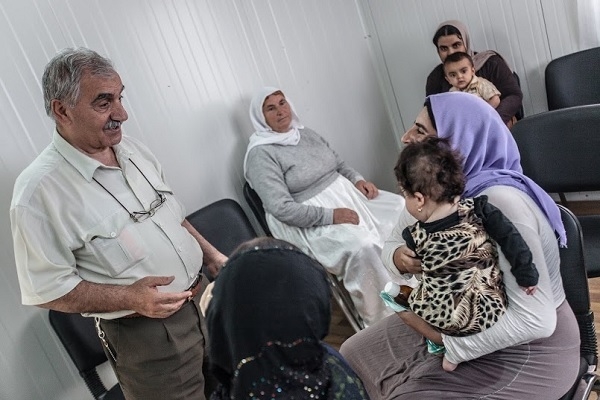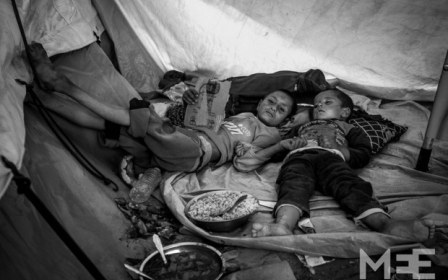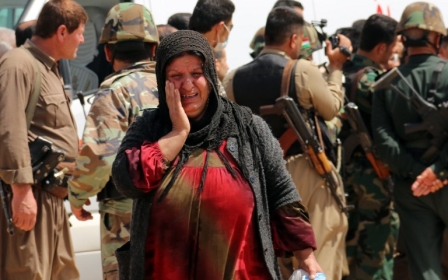How one man’s Abu Ghraib torture led him to help displaced Yazidis

ERBIL, Iraq - Inside the Khanke camp, one of the numerous site that shelters Internally Displaced People (IDP) in Iraqi Kurdistan, Dr Wahid Harmz, 70, runs a trauma centre that welcomes Yazidis in need of psychological support.
When on 3 August 2014 the Yazidis of Sinjar came under attack from the Islamic State (IS), which believes this minority to be “devil-worshippers” who deserve to be tortured, enslaved or killed, tens of thousands of this millennial community were forced to flee.
For those who were abducted and abused, who lost a relative or their home, psychological conditions including depression and “conversion disorder” - a psychological health condition in which a person can experience inability to speak and paralysis after a traumatic experience - are often diagnosed, said Harmz. Others were diagnosed with post-traumatic stress disorder (PTSD), a crippling mental illness often found among war veterans.
To help those in need, the Jiyan Foundation (“life” in Kurdish) opened the centre last February in Khanke, situated near the city of Duhok. Inside the white prefabricated shelters put together to form the clinic, more than 50 patients a day are welcomed by three doctors, two psychotherapists and Harmz, the only certified clinical psychologist in the centre, perhaps even in the whole country, according to him. The work is difficult, but their services are free of charge.
In addition to the PhD he received in Saint Petersburg in 2000, Dr Wahid Harmz also uses his personal experience to help the Yazidi community. Much like them, he knows what it’s like to fear for one’s physical integrity and having to flee one’s home. “In order to help people, you have to understand the reasons behind their traumas,” explained the doctor.
Imprisoned for three years during the Saddam Hussein era in the infamous Abu Ghraib penitentiary (a place of detention and execution of political prisoners which later became a US military prison during the Iraq war), Harmz said he was tortured weekly. “They would give me electric shocks, beat me up and make me walk on a wooden board with nails,” he recalled. During his years in prison, he was either confined with 70 fellow political prisoners in “a big hall,” or, when punished, thrown in a cell so small he could barely lie down. There, the only source of light was a narrow hatch used to serve food.
Along with the physical pain, psychological torture was used too. “They would often tell me they were going to sexually abuse me,” said the doctor. And even though they never did, the fear was constant. But Harmz insists that he didn’t develop any psychological trauma from his time in Abu Ghraib, and that by holding onto his leftist political beliefs - the very same political thought that had him arrested in the first place – kept him sane. “I didn’t give up, I was proud to be stubborn,” he said. But this doesn’t mean the experience doesn’t haunt him and it’s never far from his thoughts.
After his release, Harmz decided to seek refuge in Sweden and Russia, where he lived for more than two decades before returning to Iraq in 2006, when he no longer feared the repression from Hussein’s government. Having been both physically abused and homeless, Harmz says he knows what Khanke’s Yazidis are going through. “It’s a benefit for me, it helps me understand my patients and the situation they are in,” he said.
'I don’t sleep anymore'
As a teenage girl from Sinjar waits for him, the doctor heads toward the consultation room, where he is quickly joined by one of his colleagues. He tries to make her laugh and succeeds. She smiles shyly, but still keeping her eyes fixed on the ground.
“She used to be good in school but now failed two classes,” explained Khairy Murad, a psychotherapist in the centre and Harmz’s student in Zakho University, situated 50 kilometres away from Khanke. The 16-year-old girl that now lives with 14 people in one tent was diagnosed with symptoms of depression and “disadaptation,” a mental disorder defined as the psychological incapability to adapt to and accept a different life. “She is sad, worrying, always thinking of her home with nostalgia,” explained Murad.
Much like Harmz, Murad uses his own experiences of war and trauma to connect with his patients. As a Yazidi, he too had to flee the IS onslaught and see hundreds of his fellow Yazidis killed, and thousands enslaved. Talking about this is painful, but Murad still has to do it every day.
“It’s difficult for me, but it’s my job to help them. I try my best to hide my grief,” he said.
In the small waiting room that never seems empty, two Yazidi women are left waiting for their medical consultation before the centre closes. For some patients, the NGO provides basic medical care, for others, it is a vital support in the face of profound traumas.
“Twenty-three members of my family were abducted by Daesh [IS],” explained Halo Khdr, a 45-year-old mother of five who is visiting the centre for the third time. “I don’t sleep anymore. I am always thinking of them and wondering where they are,” she added.
During her first appointment, she was diagnosed with Major Depressive Disorder (MDD), a mental illness characterised by persistent feelings of hopelessness, a lack of self-esteem and a loss of interest in activities once pleasurable. “I was always angry,” recalled Khdr, who said that she has at last started to feel better.
Her mother and nephew were among the Yazidis that successfully escaped IS’s clutches but she is always reminded of those who were less fortunate. Held captive, Yazidi women and girls in northern Iraq are systematically raped and subject to other sexual violence carried out by IS which trades them as goods.
In a video published last November, alleged IS militants happily discuss the transaction of enslaved Yazidis as “today is the slave market day.” “Where is my Yazidi girl? Where is my Yazidi girl?,” shouts one of them, waiting to buy a woman whose price depends on her age, the colour of her eyes and her physical health. “What would I need her for if she has no teeth?” asked another one with a wide smile.
Although only a minority of Khanke’s patients were sexually abused, their treatment is especially challenging and can take much longer to yield results.
When someone is sexually assaulted, Harmz explained, the mistrust runs deep and patients’ families will often need counselling as well as the victim.
“A girl victim of rape will suspect every man and doubt everything. She was physically abused but cannot tell anyone because in our society it’s taboo. She feels like she has no value anymore, that she is worthless,” said Harmz. “I must speak with people around her, like her father and her uncles, to tell them that being physically abused was not her choice. It’s difficult, they understand what I say but don’t always accept it.”
Before Khanke, Harmz already worked with victims of sexual assault, but in a more secretive manner. Blaming the deep conservatism of the region, he says that the women he treated had to hide the cause of their traumas in order to keep their honour untouched, or take the risk of being killed by their own family.
Hopeful but realistic, Harmz knows that more remains to be done before sexually abused Yazidis women can rebuild their lives, as coming back home is only the first step of rehabilitation.
“I have no doubt in women’s mentality, I only focus on men’s attitudes: that’s what need to be changed,” he said. “They need to understand that rape is not the responsibility of the victim.”
Middle East Eye propose une couverture et une analyse indépendantes et incomparables du Moyen-Orient, de l’Afrique du Nord et d’autres régions du monde. Pour en savoir plus sur la reprise de ce contenu et les frais qui s’appliquent, veuillez remplir ce formulaire [en anglais]. Pour en savoir plus sur MEE, cliquez ici [en anglais].




